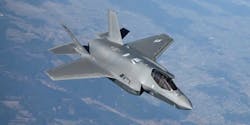Navy asks Lockheed Martin to set up obsolescence-mitigation program for electronic parts on F-35 combat jets
PATUXENT RIVER NAS, Md. – U.S. Navy combat aircraft experts are asking Lockheed Martin Corp. to set up a program to mitigate obsolescence of electronic components over the lifetime of the nation's fleet F-35 combat jets.
Officials of the Naval Air Systems Command -- the purchase agent for all U.S. F-35 aircraft -- announced a $25 million order last month to the Lockheed Martin Aeronautics segment in Fort Worth, Texas, to provide diminishing manufacturing source (DMS) management for the F-35. Lockheed Martin is the primary F-35 designer and manufacturer.
DMS refers to the obsolescence of electronic components such as computer processors, field-programmable gate arrays (FPGAs), power supplies, and databus interface chips. These components go obsolete much more quickly than weapons systems like the F-35, so the military has to plan for supplying integrating modern parts as the obsolete parts that need replacing become difficult to obtain.
This order calls for Lockheed Martin to review and identify actual and potential DMS issues of components, parts, materials, assemblies, subassemblies, and software items, and recommend solutions to mitigate issues in support of the F-35 aircraft.
Related: COTS in space: Addressing obsolescence, part I
The Lockheed Martin F-35 joint strike fighter has been in development for more than 27 years, even though the plane is one of the newest combat aircraft in the world. Now consider that the average life spans of commercial electronics spare parts are three years or less.
The most direct way of dealing with DMS electronic parts is to make lifetime buys -- essentially buying up every part that manufacturers have on hand before they stop production entirely. Even after making lifetime buys, systems integrators sometimes eventually must rely on aftermarket parts manufacturers, parts brokers, or the so-called "gray market" to keep spare electronic parts on hand.
It can be a time-consuming and expensive task to ensure that obsolescent parts remain available for military weapons platforms like the F-35, which must remain in top condition for many decades.
Without such a supply of spare electronic parts, systems integrators like Lockheed Martin would be faced with redesigning electronic subsystems with the latest generations of electronic parts. As attractive as that sounds, it's even more expensive and time consuming than keeping obsolescent spare electronic parts on hand.
Redesigning a complex electronic subsystem takes a long time, and an even longer time to certify for safety and performance. Most likely this quarter-billion-dollar investment the Navy is making in F-35 spare parts in the long run will end up being a good deal.
On this order Lockheed Martin will do the work in Fort Worth, Texas, and should be finished by July 2023. For more information contact Lockheed Martin Aeronautics online at www.lockheedmartin.com/en-us/who-we-are/business-areas/aeronautics.html, or Naval Air Systems Command at www.navair.navy.mil.
About the Author
John Keller
Editor-in-Chief
John Keller is the Editor-in-Chief, Military & Aerospace Electronics Magazine--provides extensive coverage and analysis of enabling electronics and optoelectronic technologies in military, space and commercial aviation applications. John has been a member of the Military & Aerospace Electronics staff since 1989 and chief editor since 1995.
